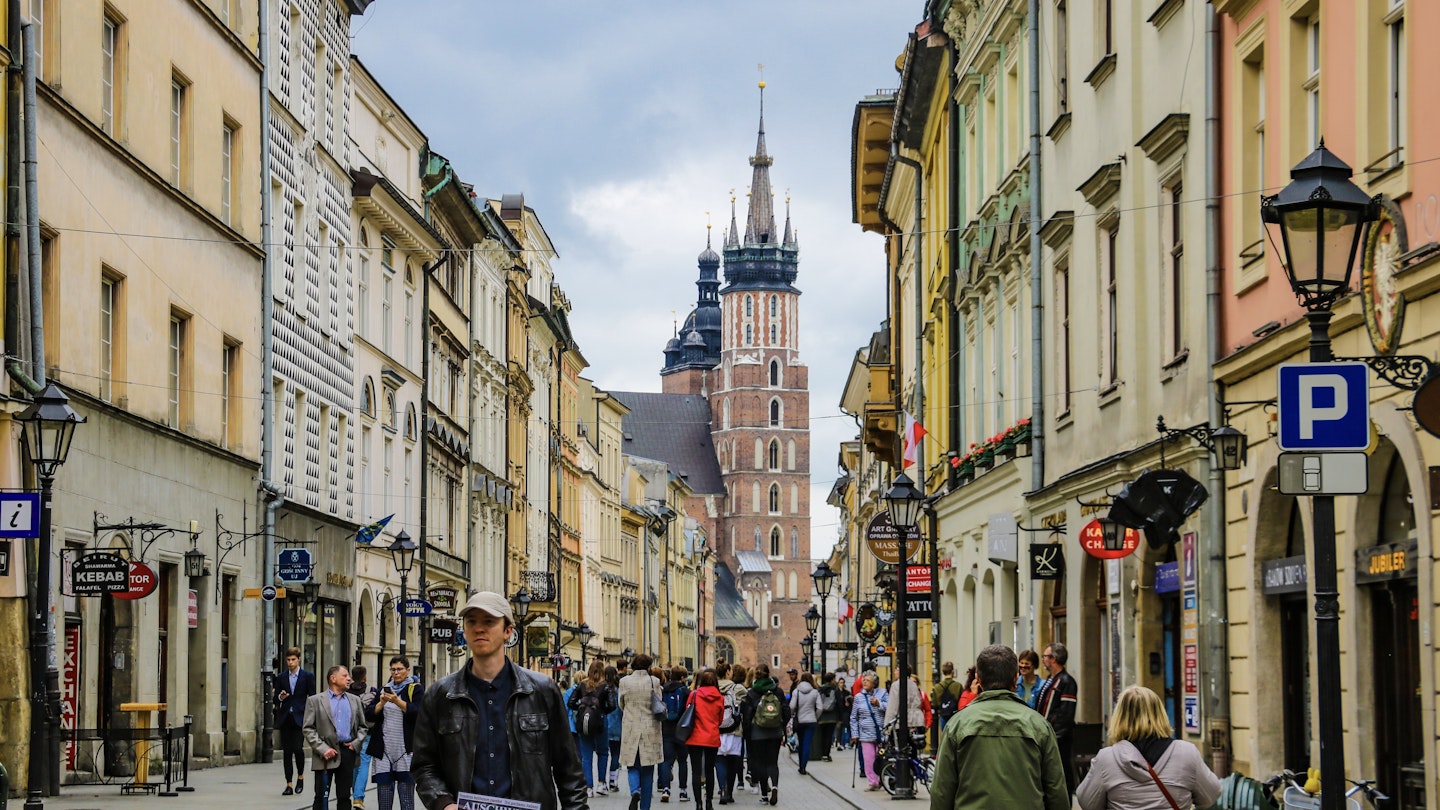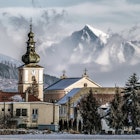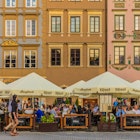

Delightful Kraków combines the historic with the cosmopolitan. Read on to find out the best ways to get to know the city. Shutterstock
Crowned with an impressive royal castle and dotted with church spires and world-class museums, Kraków combines the historic with the cosmopolitan.
The crowds that throng Kraków’s main square and the restaurants lining photogenic Old Town lanes buzz with 21st-century joie de vivre – while the streets of former Jewish quarter Kazimierz and nearby Auschwitz are sobering reminders of 20th-century tragedy.
Beyond the must-see attractions, visitors can seek out simple local pleasures. Strolls alongside the Vistula River, and hearty home-style cooking in a retro bar mleczny (cafeteria). Sets by local bands at a legendary dive bar and fabulous art-nouveau architecture.
Ready to plan your visit? These are the best things to do in Kraków.

1. Feel Poland’s glorious past at Wawel Royal Castle and Wawel Cathedral
Overlooking Old Town from its Wawel Hill perch, the seat of Polish royalty for centuries is the city’s most impressive sight – not to mention a national symbol of Poland and a deep source of local pride. Red-roofed, turreted and ringed by a red-brick wall, this 16th-century Renaissance palace is merely the most recent incarnation of this monument: royal residences on the site have come and gone (burned down, extended, vandalized by Swedish and Prussian armies…) since the 11th century.
Highlights include the 16th-century tapestries and carved wooden heads in the grand state rooms; royal private apartments that give you an intimate glimpse into the monarchs’ private lives; the crown jewels of the treasury; and the Szczerbiec (jagged sword), which played an essential role in Polish coronations from 1320 onward (you’ll find it inside the vaulted Gothic armory).
Give yourself plenty of time to visit adjoining Wawel Cathedral, where many of Poland’s kings and queens are seeing out eternity in elaborate tombs, alongside the bones allegedly belonging to the legendary Wawel dragon. While the grounds are free to visit, it’s a good idea to book tickets for exhibits you want to see at least two weeks ahead due to their enormous popularity.

2. Get all medieval in Główny Rynek (Main Market Square)
Surrounded by restaurants and overlooked by handsome, centuries-old buildings, Główny Rynek (Main Market Square) is the focal point of Old Town – not to mention the largest medieval town square in all of Europe. After you’re done browsing the wares inside the market building, go back in time by descending to the medieval-meets-the-21st-century museum beneath the square.
Clever multimedia displays, holograms and animated puppets show you medieval market stalls and teach you about vampire-prevention burials. Buy your timed ticket online in advance – or visit on Tuesdays for free entry. Note that the museum is closed the second Monday of each month.
3. Spend a night out a at “lost bar” (if you can find one)
Other cities have speakeasies; Kraków has its “lost bars.” These hidden drinking dens are a recent development in Kraków, and they’re a fun addition to its nightlife scene. To find one of the best ones, head to Smakolyki restaurant on Floriana Straszewskiego, find your way to the cloakroom and pass through to a hidden courtyard – and the entrance to Mercy Brown. This Jazz Age–style joint is all velvet couches, mood lighting, chandeliers and cocktails from a bygone era (gin with jasmine tea cordial, anyone?). Completing the immersive experience, entertainment includes burlesque shows.

4. Confront brutal history at Auschwitz-Birkenau
You don’t know what will move you the most until you get there. For some, it’s the torture cells and crematorium of the “Death Block.“ For others, it’s the gas chambers and the endless rows of crematoria chimneys at Birkenau, where most of the mass killings occurred. For others still, it’s the mountains of eyeglasses and prosthetic limbs, the mass of human hair collected from victims to be used in textile production, and piles of battered suitcases with home addresses written on them by those for whom this Nazi extermination camp became their final destination.
In any case, Auschwitz is unlikely to leave you untouched. More than a million Jews, as well as numerous Poles and Roma, were systematically killed here between 1940 and 1945. The death camps have been preserved as a brutal, essential lesson of what humans are capable of.
Auschwitz is reachable by bus, train and organized day tour from Kraków. While solo travelers can visit the site without a guide, it’s well worth joining a tour to get the most out of the experience, from the screening of the graphic 1945 documentary film by the Soviet liberators to the exhibitions in the barracks.

5. Take a dip in Zakrzowek
Tall limestone cliffs and dense pine forest surround this lagoon, whose clear, turquoise waters make it feel a million miles away from urban life. Yet this idyllic site is only a short tram ride (on route 1 or 4) to Kapelanka, southwest of Old Town. The lagoon was once a limestone quarry, which was deliberately flooded in 1990 after falling into disuse. It then became a popular swimming and picnicking spot for locals. After a recent overhaul, five swimming pools of varying depths are now enclosed within the lagoon, all connected by wooden docks – making this a fabulous spot to cool down in the summer heat.

6. Explore the past and present of Kazimierz
Southeast of Old Town, the Kazimierz neighborhood was Poland’s most important center of Jewish culture for 500 years – until the mass deportation and extermination of Kraków’s Jews by the Nazis emptied it. Largely rundown during the Communist era, Kazimierz has bounced back in recent years.
Stroll through its streets to get to know its historic sights, from the restored Old Synagogue and a 19th-century Jewish cemetery with surviving tombstones to the Moorish-style Temple Synagogue and the sobering Galicia Jewish Museum, which traces the history of Jews in Kraków. Browse the flea markets on Plac Nowy on the weekends, or attend a film screening or concert at Cheder during the Jewish Culture Festival.
7. Dine local a local at a bar mleczny
Cheap, cheerful and with seriously retro decor, a bar mleczny is a time-warp step behind the Iron Curtain and into 1980s Poland – in the best way. Found all over the city, bar melczny are dirt-cheap cafeterias where you’ll rub shoulders with locals while you load up your tray with soup, pierogi (filled dumplings), placki ziemniaczane (potato pancakes) and other hearty, belly-warming staples – all for a song. There’s a branch at Grodzka 43 in Old Town and another at Starowiślna 29 in Kazimierz.

8. Be moved and inspired at Schindler’s Factory museum
You’ve surely heard of Oscar Schindler, the German industrialist immortalized in Steven Spielberg’s 1993 film Schindler’s List. During WWII, Schindler saved more than 1000 Jewish inhabitants of the Podgorzé ghetto from deportation to the death camps by employing them at his enamel factory, still standing today. Schindler's Factory museum, where part of Schindler’s List was filmed, was given a major facelift in 2010 and has become one of Kraków’s must-visit museums. Book your timed slot online at least 3 days in advance (it’s hugely popular), and don’t miss the superb permanent exhibition, “Kraków During Nazi Occupation 1939-1945,” which tells the story of everyday life, underground resistance and anti-Semitic repressions in the city during the war.

9. Gorge yourself on street food
Paris has its croissants, Hanoi has its banh mi, Vienna has its Käsekrainer...and Kraków has its obwarzanek. Chewy and addictive, and topped either with poppy or sesame seeds, Kraków’s bagels are found at stalls on every corner in Old Town. Locals will gladly tell you which stall is likely to have the freshest lot.
But there’s more to Kraków’s street dining than bagels. For the best kielbasa (signature Polish sausage) in town, head for the Kiełbaski z Niebieskiej Nyski van in front of the Hala Targowa market on ul. Grzegorzecka. Then there’s zapiekanka – half a baguette topped with melted cheese, mushrooms and a squirt of ketchup. Poland’s answer to pizza was invented in the 1970s, when basic ingredients were all you could get; today, versions with fancier toppings are ubiquitous at fast-food stands. For numerous zapiekanka sellers under one roof, try the Okrąglak food court at Plac Nowy in Kazimierz.
10. Catch a live set at Klub Awaria
Klub Awaria is the kind of dingy dive bar that your mother warned you about: a sticky-floored, vaulted-ceilinged saloon where the carpe-diem clientele will gladly press a drink into a sober stranger’s hand to help them participate in the mildly anarchic nightly revelry. Up-and-coming local blues and rock bands perform on the little stage most nights – and after the band is done, regulars occasionally dance to Tina Turner classics on the tables and even the bar itself.

11. Get a taste of everyday life under Communism at Nowa Huta
If you want to see how steelworkers lived in the 1950s, catch tram 4 or 10 from central Kraków to this masterpiece of socialist-realist urban planning and Communist architecture in the east of the city. If wandering around the uniformly grey, identical blocks of flats isn’t enough of a draw, you can take a tour of Nowa Huta in a vintage, Communist-era Trabant with Crazy Guides, who’ll bring you down into the old nuclear fallout shelters and ply you with vodka.

12. Take a leisurely cruise on the Vistula
The slow-flowing Vistula River bisects Kraków. Join locals during their morning runs along the footpaths that run alongside the river banks for several kilometers from near Wawel Castle to the city’s eastern suburbs, skirting Kazimierz along the way. Alternatively, if you have local friends, you might be invited aboard a party boat with a full bar and music system; these are available for hire by groups and are essentially floating nightclubs. More easily accessible are hour-long cruises that depart below Wawel Castle Hill and show off the city’s important landmarks, such as the Dębnicki Bridge, the Norbertine Monastery, the Manggha Museum of Japanese Art and Technology and the Piłsudski Bridge.

13. Climb to the top of Kopiec Kościuszki
When you’re standing on Wawel Hill, you may notice the lump-like green hills surrounding Kraków. The origins of the Kraków Mounds are lost in the mists of time, though it’s believed that the two oldest – Kopiec Krakusa and Kopiec Wandy – were built by pagan tribes several millennia ago as part of some solar calendar. (During the summer solstice, the sun rises at Wandy and sets at Krakusa.) Kopiec Kościuszki is a newer pile, completed in 1823 to commemorate a fallen Polish general. Catch bus 100 to the mound for fantastic views of Wawel Castle, St Mary’s Basilica and Główny Rynek.

14. Descend into the Wieliczka Salt Mine
This UNESCO-certified subterranean labyrinth of passages and chambers has been drawing visitors since the 1720s. (While the massively popular attraction is not actually in Kraków proper, it’s is easily reachable from the city.) It’s not for the claustrophobic: as part of a “tourist” tour, first-timers descend at least 125m (410ft) belowground and spend 2 hours in the depths of the former mine. Return visitors can opt for a more immersive miners’ tour.
Highlights include an underground lake, chapels adorned with statues carved from the white stuff, and a salt “cathedral” with chandeliers. And yes: everything around you is carved from salt (we licked the wall so that you don’t have to). You can reach Wieliczka Salt Mine easily from Kraków by bus, train or tour. Pack a sweater.
Explore related stories




 HikingWhere to go in Slovakia for castle ruins, mountain hikes and city culture
HikingWhere to go in Slovakia for castle ruins, mountain hikes and city cultureJul 25, 2024 • 8 min read






